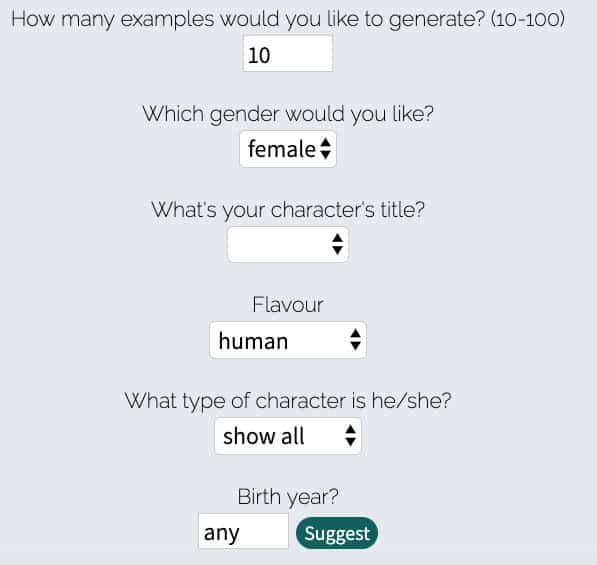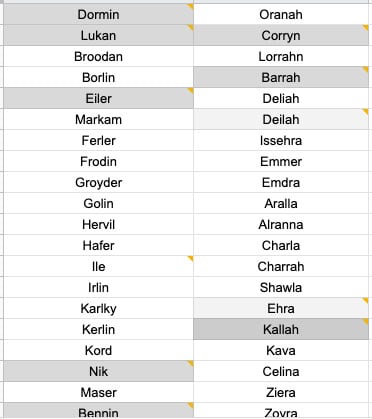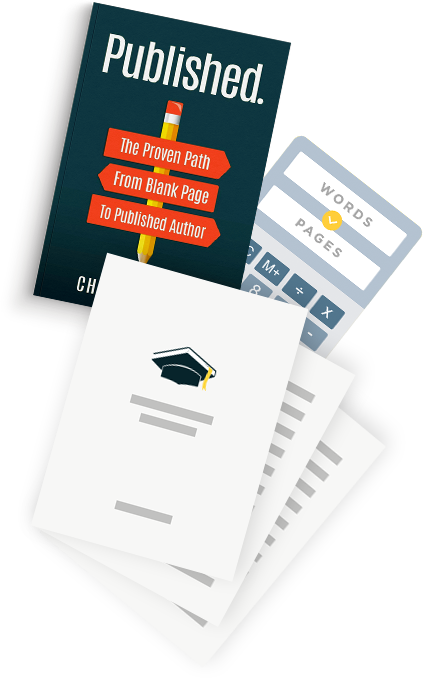Your character names have the ability to transform the perception readers have of your book and story.
If you think about it…character names are actually a specific literary device you can use most sneakily.
And if you want readers to love, adore, and care for your main character, giving them the best and most memorable name can make all the difference.
Use these methods for naming characters in your book:
- Using baby name websites
- The Root-Meaning method
- Mash-up character naming method
- The Add-on method
- Develop-First naming method
- Making character names up from scratch
- Naming-by-era method
- Using similar-to-real-life names
- 11 tips for getting character names right
Naming Characters Intentionally: Why Character Names Matter
Character names have the power to transform your reader’s perception of your character entirely.
Let’s use the example of names from How to Train Your Dragon, the animated film.
Character name example: Hiccup
Why this character name matters: This name is extremely fitting to the type of character Hiccup is. The reason for a silly, “weak” name like this is because that is what the creators want you to think of when you hear the name. They want you to have low expectations so that when this character rises above, the emotional impact is far greater than if he had a typical “hero” name.
You can use this same ideology for villains. One in particular with a famous name is from Harry Potter.
Character name example: Lord Voldemort
Why this character name matters: From the beginning, Rowling crafted this name to be foreboding. In fact, this character himself chose the name because of that. As the author, you can craft your villain’s name based on your intentions. If you want readers to underestimate them, choose a silly name like Bob. But if you want readers to fear the wrath of your villain, choose a more fitting name like Lord Voldemort.
Character Name Generators
If you’re looking for the easy way out and would rather someone else do the work in naming your characters, there are tools online for that.
Here are some of the top character name generators:
- Character Name Generator – This one allows you to fill in several different defining factors in order to produce a character name that fits your character best.
- Fantasy Name Generator – Are you writing a fantasy novel and need some character name ideas? This generator offers several different options for theme-based character names for your fantasy book.
- Name Generator for Fun – With this one, you can choose from several categories, like villain names, rap names, superhero names, and more.
- Writer’s Character Name Generator – While very random, this one may just allow you to stumble upon your next main character’s name.

How to Come Up With Character Names
Naming your characters is one of the best and scariest parts of writing a novel.
Using one of these methods will help ease the process while providing higher quality final results.
1 – Baby Name Websites
One of the most popular methods of coming up with new character names is to pretend they’re your baby…literally!
Baby naming websites have been serving up characer names for writers for years.
Oftentimes, these websites even offer name meanings, trending names, and even names that were popular doing different years.
Here are some great baby name websites to discover your characters’ names:
2 – Root-Meaning Method
Welcome to the most common, tried-and-true method to name characters in books.
People use this method in real-life to name their children, too!
The root-meaning method simply refers to using a core meaning or belief or even origin of a name for symbolism in your book.
Here are some examples of this:
- Tobias Kaya in The Savior’s Champion: His name means “goodness” and is very much meant to align with who his character is and his role in the series.
- Frodo Baggins in Lord of the Rings: Little do most people know, the name Frodo originated from the old English word “fród,” which translates to “wise by experience.”
- Katniss Everdeen in Hunger Games: This book’s author really took the name meaning seriously when crafting her main character. Katniss is a plant in the genus Sagittaria, which roughly translates from Latin as “archer.”
You can easily find the meanings of names by venturing to baby naming websites. You can also type in a name you like to Google and it will usually pop up.
3 – The Mash-Up
One of my personal favorite ways of creating new names is to simply mash real-life names together until I find something that’s real-sounding but also unique to my world and characters.
This method of coming up with character names is better learned through seeing than a simple explanation:
Josh and Riley = Joley, Jile, Rosh, Rishe
Casey and Michael = Cachel, Cachael, Casel, Misey, Miche, Michey, Masey
Emily and Rochelle = Emelle, Echelle, Romil, Romily, Rochil, Rocily
Obviously, some combinations will be better than others, but this is a quick way to generate new but realistic character names.
Here’s the step-by-step breakdown for how to create simple character names with this method:
- Choose or find 2 real-life names
- Match them side by side
- Take the first half of the first name and mix and mach it with the last half of the second name
- Repeat step 3 but vice versa
- You should have a list of several different sounding names
- Choose a few to keep that you like
- Repeat this process with several pairs until you have a roster of character names to choose from
4 – The Add-On
This method is super similar to the previous method but with more freedom.
This is another personal favorite and how I manage to come up with cool and interesting names that are also unique to my story.
Instead of taking two names and matching the beginning of one with the end of the other, simply choose real names and swap out the endings or add on to them completely.
Here’s what this looks like…
Rebecca = Rebera, Rebilla, Rebyr, Rebine, Reborra
Taylor = Tayr, Tayora, Tayrin, Taysila, Tayserra
Cory = Corrin, Corel, Coreesa, Coryn, Corros, Cortsa, Corta
John = Johva, Johrrin, Johk, Johrey
The steps for this one are pretty obvious. Choose a random real-life name and simply swap out the endings for a combination you create on your own.
I always try to do varying combinations, remembering that double consonants work well, as does changing the length of the vowel sounds by adding or changing those letters.
I do this often and keep a spreadsheet with names I like, as in the image below.

5 – Develop-First Naming
Sometimes choosing a character’s name too early will make you subconsciously develop that character into someone who fits that name.
This can be bad if you need that specific character to act and behave in a certain way.
With this character naming method, you will develop your character in full first and then choose their name. The reason for this is to ensure you’ll write that character with intention.
For example: in the Harry Potter series, the mood tends to be more serious. Rowling created Ron Weasley as comedic relief. While Ron is much more than that, the intention is still for him to be a goofy, funny character.
The name “Ron Weasley” supports this development.
Had she named him a more serious name like Reginald, Theodore, or Christopher, crafting those scenes may have been very different.
The same can be said for another character called Draco Malfoy. This name is far more dark than it is funny, which is fitting for his character.
The steps for this character naming method are simple:
- Download and fill out this character development worksheet.
- Understand your character’s role in the story. Do you want them to be serious, funny, silly, foreboding?
- List names that make you feel the way of your intentions.
- Ask friend and family to tell you what each name makes them think of personality-wise.
- Narrow down your choices to 3 and ask another group.
- Decide on the best-fitting name.
6 – Make Them Up
If you want to have 100% unique character names (like Lhonniadreah, a character in the book I’m writing, Lhonni for short), you’ve got to get creative.
But you’re a writer, so you know how to get creative.
This particular method doesn’t have many rules.
Essentially, you can simply think up a random name. Perhaps you have a base or a beginning that you like.
For example, my full original name for the character mentioned above was Lhonni. But I felt her character needed a longer name to fit with the traditional style of the names in her culture.
Secondly, I decided to pull from the common letter match-ups this culture sees often. In this case, the combinations of the “dr” sound with long vowels is popular.
I went on to create several combinations of potential full names:
- Lhonnidray
- Lhonniyadra
- Lhonniodrin
- Lhonnidra
Ultimately, the name I chose best fit her as a character, and I decided afterward that her mother’s name would be “Dreah,” so that her name is a namesake that’s in common format for the culture I created.
Here’s how you can replicate this process:
- Write down a sound or start or end of a name you like (this can be a “-ly” ending, an “ash-” beginning, or even an “-eer-” middle of a name.
- Decide if you want the name to hold any significant meaning the way mine does. This does not have to be the same meaning. You can even find base words in English or Latin to use.
- Take into account any world-specific cultural influences on the name. Your world building expands to even your character’s name. Don’t forget this! (If your book takes place in this world, think about family spellings and such as a substitute)
- Create a list with several different versions and variations. Remember your character’s name can take on very different meanings and intentions based on the sound (and look!) of it.
- Choose the name that feels right and embodies your intentions for the character. And let it stew for a few days! Now, even if your character is brave and strong, like in the Hiccup example, using a less-than-obvious name can provide a unique perception that fosters a better reaction later.
7 – Name-by-era
One of the biggest mistakes you can make is unintentionally destroying your reader’s suspension of disbelief by naming a character something wildly out of the ordinary for a time period.
If you’re writing historical fiction or just a story from 10-15 years ago, you want to make sure your names are realistic for the time period.
This trick is also helpful if you want to give your out-of-the-real-world novel a specific time era vibe.
Here are some resources for baby names by era:

#8 – Using similar but different real names
The most famous author who uses this method is George R.R. Martin in his infamous series Game of Thrones.
What Martin did in order to give this epic fantasy series realistic but medieval sounding names is simply alter just a few letters in a name.
Here are some examples of names from Game of Thrones with more common real names:
- Gregor — Gregory
- Joffrey — Jeffery
- Brienne — Brianne
- Theon — Theo / Theodore
- Petyr — Peter
- Jorah — Jonah
- Gilly — Lilly
- Podrick — Rodrick
Martin has a way of completely transforming these very similar-to-real-life names into something with both a. fantastical and medieval twist in order to further transport us to his world.
Of course Game of Thrones also features completely unique names like Daenerys and Tyrion along with real-life names like Robert and Jon. Martin uses this combination to his advantage—and you can too!
Top Tips for Naming Characters in Your Book
No matter which method you choose for naming your characters, you’ll need a few tips to make it more effective.
Here are the best tips for naming book characters with intention.
#1 – Remember, length matters
This is particularly true if you have several characters who will interact with one another regularly.
If you have all very long names, your reader will be exhausted.
You don’t want that…
What you do want is a reader who doesn’t have to focus on the pronunciation or longevity of several character names.
Using a combination of long, short, and medium length names will allow your readers to read easier so they can focus more on visualizing what’s happening.
Here’s an example of this with names from my work in progress:
- Essadra
- Vhie
- Dailan
- Lhonniadreah
- Riddick
- Ket
This combination allows several of these characters to be in the same scene without exhausting or confusing the reader.
#2 – Keep nicknames in mind
You can use your character’s name as a plot device if you really wanted to.
Maybe the reveal of your main character’s full name is important to the story and your character has only been called by a nickname their whole life.
Nicknames can also serve as a way to show and not tell within your writing as well. Those close to your character are more likely to use a nickname and therefore, you don’t have to dumb as much exposition in order for them to learn.
Just make sure the nickname is also fitting and not too similar to other characters’ names.
#3 – Make sure the name fits the character
We’ve already mentioned this tip a number of times but it’s worth mentioning again.
If your character’s name is very, very ill-fitting, it will stand out in a bad way to readers.
This is why getting feedback and understanding your character fully is so vital for the naming process.
The name you choose should match your character’s traits and personality.
#4 – Make sure the name fits the setting
Where your story takes place can change the names you use for your characters.
What’s the location?
Does your story take place in a cold, harsh climate or in a dry, warmer environment?
The location matters because the names used can help enhance or take away from the mood you’re trying to create within that environment.
For example, harsher climates tend to pair well with curt, quipped names to mirror this. But if you want your character in this specific place to stand out, you can give them a name that’s ill-fitting in order to focus on this contrast.
A great example of this is Ygritte from Game of Thrones. Yet again, George R.R. Martin has named someone who lives in a tough, gritty environment with a suitable name that gives off this vibe.

What are the cultural influences?
As mentioned in a few of these tips, culture plays a large role in your characters’ names.
Does your culture, whether you make it up or it’s real, influence your character’s name in any way?
For example, in a certain culture in my work in progress, names can often be namesakes. However, instead of simply naming a baby the full name of whomever they’d like to honor, they add the name to the start of another.
Lhonnidra is a common name in a certain place of my book. However, her mother Dreah died. Her father then named her after her mother, but in this world, that would translate to Lhonniadreah instead of just “Dreah.”
Ask yourself if there are any cultural influences and if there isn’t (and you’re completely making up this world), feel free to add some!
What is the intended time period?
Even if your book takes places in a completely different world, you can still allow readers to get a sense of the intended time period you’re going for with the names you use.
For this method, use old victorian names or names from medieval times as a base when also using another method for coming up with a unique name.
Victorian name example: Emaline
Created for a unique world while maintaining the same vibe: Emarise
You can tweak the names until you find something that feels right.
#5 – Consider how each name sounds
There are several literary elements that touch on the way similar or contrastingly different sounds can play into the attractiveness of writing.
Although most people don’t read novels out loud, unless they’re reading to their kids, we all still have a voice in our head that is “out loud.”
And that voice is drawn to names that sound appealing.
This can often be a subjective element when coming up with character names, but you can probably recognize names that sound good versus names that sound bad.
But you can also use this to your advantage for further character development as well.
“Ugly” sounding names are a great fit for characters you’d like your audience to interpret as just that. It’s all about what intention you have for that character.
An example of this is the name James Bond. I think we can all agree this is a great sounding, tough name that fits the character well.
#6 – Get feedback on the names
Other people are a better judge of the first impression of a character name simply because it’s fresh for them.
Enlist 7-10 people you can get feedback from when it comes to these names.
Send the name along with 2 sentences describing the character (physically and personality) and ask them if they sound like they fit.
Oftentimes, we might really like names that are hard to read or pronounce for new readers. In that case, you’ll want to problem solve for a solution.
#7 – Don’t be afraid to go crazy with it
This is your book! This is your world and if you have names that are a little out there, that’s okay!
The only reason you’d want to reel in the craziness is if the names are too complex for readers to easily comprehend and remember.
Nobody wants a character whose name people forget when talking about the book. After all, characters are one of the first things raving fans gush about with a new book they love.
That being said, don’t be afraid of creating your own names in your own world. Real-life parents make up names for their children every day. You can do the same for your characters.
#8 – Create cultural similarities in your world
This is mainly for authors writing in a unique world they make up on their own.
Different cultures and languages have very different names and common ways to spell and pronounce those names.
Here’s a quick example of several names from opposite sites of the world in my story:
Doyen Falls
- Essadra
- Vhie
- Dailan
- Lhonniadreah
- Riddick
- Ket
Sahïl
- Nimah
- Yarai
- Déron
- Creïdon
- Ghe
- Anahi
If your characters are from very different areas, the names should reflect that, just like in life.
#9 – Avoid using already-popular book character names
Using the name “Harry” or “Katniss” isn’t the best idea. At least…not if you want your characters to be remembered as your characters.
With infamous names, it’ll be very hard to set your character (and therefore, your book) apart.
If you want to use a name and aren’t sure if it’s in another super popular book, just do a Google search for “Name in book” and if it doesn’t populate a very specific result, you’re in the clear.
#10 – Avoid similar names if your character is based on someone you know
All writers draw inspiration from the real world. They’re lying if they say otherwise.
BUT, if you do base a character on someone you know in real life (which we recommend you change enough that they wouldn’t know anyway), don’t use a name that’s similar for the character.
This can make people feel very uncomfortable, not to mention it’ll be that much more obvious to outsiders who know you.
#11 – Bring your characters to life
Don’t just name your characters and leave them to exist only in your imagination and future conversations of friends or family asking you if you’ve finished your book yet.
Give them a world by finishing and even publishing your book.



